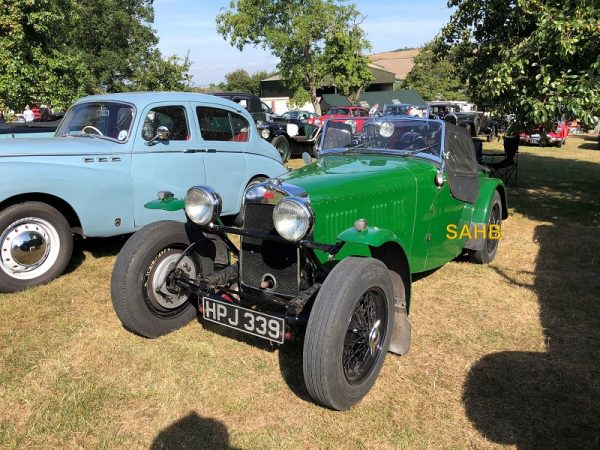
HRG Engineering Company was founded in 1936 in Tolworth, Surrey by Major Edward Halford, Guy Robins (formerly of Trojan) and Henry Ronald Godfrey. Its name was created from the first letter of their surnames. They produced cars from 1935 to 1956.
Godfrey was the “G” in G.N., a company that he founded in 1910 with Archie Frazer-Nash (the “N” in the name). G.N. cars were built until 1923 and traded until 1925. After leaving G.N., Godfrey formed H.R. Godfrey Motors, providing G.N. spares and rebuilds. This company evolved into Godfrey-Proctor, which traded until 1928. Proctor later joined HRG in 1950 as technical director, replacing Guy Robins.
Although the HRG has conventional engine and transmission, its lightweight sporty appearance is clearly influenced by the ‘chain-gang’ GN and Frazer Nash cars that Godfrey would have known so well. The first HRG cars were powered by 1.5-litre Meadows engines and cost £395, about half the cost of the 1.5-litre Aston Martin, and weighed almost 1000 pounds less – so they were speedy machines.
The car in our Snapshot is a Singer-powered version of 1100cc. In 1938, the company announced their 1100cc model with a shorter wheelbase, using an OHC engine from Singer’s Bantam Nine. This was joined in 1939 by a new 1500cc HRG; this replaced the old OHV Meadows engine with the Singer Twelve OHC unit.
After the war, HRG continued to make the 1100 and 1500 2-seaters to the same pre-war design – so it was only by talking to the owner of this example that it was possible to date it (although there is some speculation that pre-war cars have a glove compartment and post-war ones do not!).
The cars raced before and after World War II. In the 1938 Le Mans 24-hour race, the works entry powered by a 1500cc Singer engine, driven by Peter Clark and Marcus Chambers, was the highest-placed British car (10th out of 15 finishers from 42 starters). The following year Clark and Chambers returned to win the 1.5-litre class. In 1949, an HRG again won the 1.5-litre class at Le Mans, driven by Eric Thompson and Jack Fairman.
Sports car production ended in 1956 after 241 cars had been made, although the company remained as an engineering and development business, working for such companies as Volvo. In 1965 they also made a prototype Vauxhall VX 4/90-powered sports car. HRG ceased trading in 1966, making a profit until the end.
And finally, a remarkable statistic: of the 241 cars made, it is estimated that 225 survive, with many of the cars still active, some of them in competition.







Leave a Comment